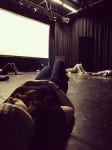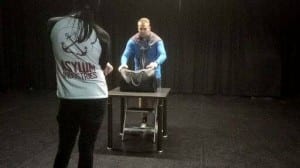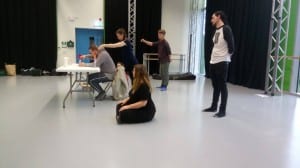In his book ‘The Empty Space’ (1968), Peter Brook explains “A man walks across [an] empty space whilst someone else is watching him, and this is all that is needed for an act of theatre to be engaged” (Brook, 1996, 9). It has always been apparent that ‘Orchid’ would be a heavily physical piece. Indeed, the very first material we began to explore were the Interlude scenes, which involve the Cyclist’s ritual with the orchid and the mysterious Woman watching over him. This is why I believe that Brook’s words have relevance here. The Interludes, considered by the company as the thread that runs throughout ‘Orchid’, must engage the audience without the use of words. They must show instead of tell, using space and proxemics to their advantage. With the four Interlude scenes and the final dance we have in their current form, the choreographer Kerrie and I worked very closely to achieve the vision we all wanted. We began by deciding to work on these scenes separately, with only her, Jacob (who plays the Cyclist) and myself present (in fact, we have only just begun bringing the rest of the company to these rehearsals). We felt workshopping these scenes with just the three of us allowed us to be more focused on them, and also allowed the main rehearsals to be entirely for work that included the whole company. In the earlier smaller rehearsals, I began being surprised at how passive my role was. I felt as though I should be doing more but, at that point, there was not much more I could do. As Katie Mitchell puts it, “it [is] best to rely on people who [are] trained in these specialised fields to lead the work directly” (Mitchell, 2009, 96). As I quickly began to realise, my role early on was to make sure that I was very clear in communicating to Kerrie what I needed from the movement, so she could adapt and develop her own ideas in the rehearsals, and to avoid the rest of the company being “pulled in two different directions” (Mitchell, 2009, 96). It made sense to me in these earlier rehearsals to make notes on the other aspects of the scene e.g how I saw the lights and sound to be, were the proxemics/sight lines looking correct etc. When the specific movements were decided upon and rehearsed to a degree, then we began looking deeper into the performances of Jacob and Kerrie. Of course, I had always used words like manipulation and envy to describe the Woman’s movements, but here was when we began implementing them rigorously.
Although a contradiction with the title of this post, music was extremely useful to not only the show itself, but to our process. Focusing before a rehearsal or workshop is integral to the success of it. I found using one track at the beginning of most rehearsals very effective in focusing the company, as it eventually became routine to get into the space, lie down with eyes closed, and listen to the song in its entirety before beginning. This is the song I used below:
Works Cited
Bianca S (2012) Enter Shikari – Constellations [online video]
Brook, P. (1996) The Empty Space. New York: Simon & Schuster.
Mitchell, K. (2009) The Director’s Craft: A Handbook for the Theatre. London: Routledge.


